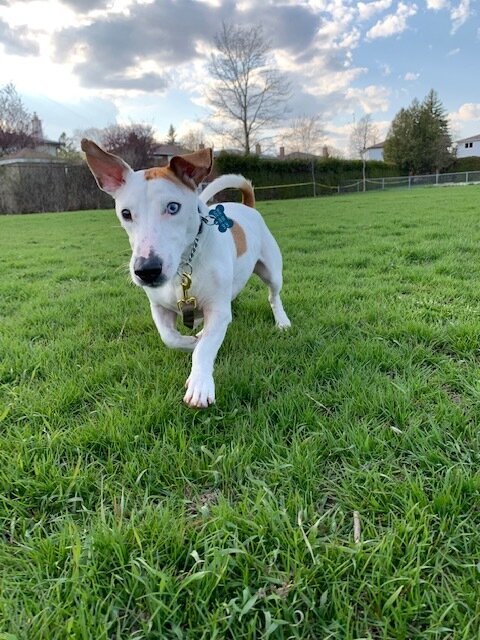Jax with his adopter, Caitlin.
“I just loved him from the moment I saw him.” As soon as Caitlin saw Jax’s picture on social media, she knew she wanted to give him the healthy, happy home he deserved. To ease her family into the idea, she began fostering him in December, and it wasn’t long before everyone fell in love and agreed that he should be a permanent member of the family. Even their English Mastiff, Alice, who is not aggressive but is easily jealous, got along with Jax immediately, so Caitlin and her family took that as a great sign. “He didn’t even care that he was somewhere new,” says Caitlin, remembering when they first brought Jax home. “He acted like he had been there forever.”
Jax was found in an abandoned factory in downtown Toronto, tied to a shopping cart. He was severely underweight and ate what was available to him at the time: garbage. When he arrived to CCR, he was put on a medical hold for a couple of months because the tips of his ears bled quite frequently, most likely due to frost bite from the cold winter months outside and the lack of body fat to keep him warm. “He wasn’t in pain, but they would bleed a lot,” said Caitlin, CCR volunteer and Jax’s adoption mom. He was put on steroid medication to help clot the blood and stop the bleeding.
He used to bark at the neighbours and dart to the door whenever he heard commotion outside, but he is no longer on high alert after having settled in over the past few months. He used to be desperate for food but now that he knows it will always be available to him, he’s evidently more at ease.
Caitlin loves seeing dogs thrive in their new homes, so it’s especially rewarding to know that she could provide that sanctuary for a dog who hadn’t had that comfort before. “They finally understand that not everyone in the world is going to hurt them or starve them.”
Caitlin says Jax’s personality continues to shine brighter as time passes. He loves food, toys, running around the backyard and going on adventures, but he does not like water. He sleeps in Caitlin’s bed, but every morning he will go room to room and greet Caitlin’s parents and her sisters.
Some habits die hard, and Caitlin says Jax does get into the garbage sometimes, but they bought him a lot of interactive dog toys to keep him occupied and steer him away from getting into trouble. He’s a very neat boy, and once he’s done with his toys, he will put them back where he found them. She says he’s a crazy, funny dog and brings a smile to everyone.
Caitlin says while some rescue organizations tend to mislead people, CCR is always up front with potential fosters and adoption parents about a dog’s challenges. They are very thorough with their medical procedures, and instead of trying to find the perfect dog for a person, they aim to find the perfect person for the dog.
We’re so grateful for Caitlin’s contribution to the organization, and so happy that Jax has found his furever home with her.





















